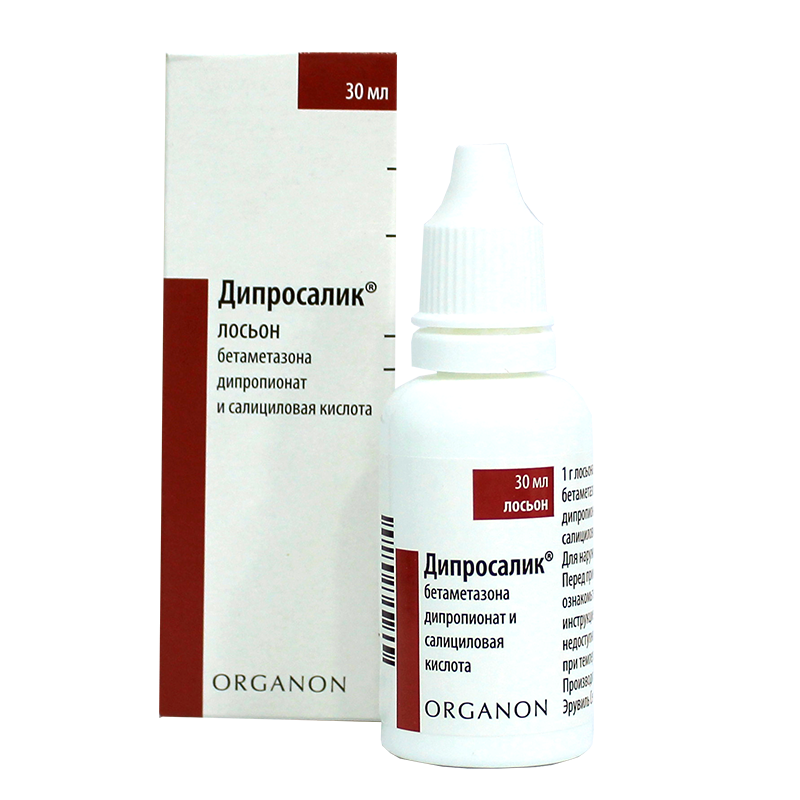

Diprosalic

Ask a doctor about a prescription for Diprosalic

How to use Diprosalic
Package Leaflet: Information for the Patient
Diprosalic, (0.64 mg + 20 mg)/g, Liquid for the Skin
Betamethasone Dipropionate + Salicylic Acid
Read the Package Leaflet Carefully Before Using the Medication, as it Contains Important Information for the Patient.
- Keep this Package Leaflet, as you may Need to Read it Again.
- In Case of Any Doubts, Consult a Doctor or Pharmacist.
- This Medication has been Prescribed to a Specific Person. Do not Pass it on to Others. The Medication may Harm Another Person, even if their Symptoms are the Same.
- If the Patient Experiences any Undesirable Effects, including those not Listed in this Package Leaflet, they Should Inform their Doctor or Pharmacist. See Section 4.
Package Leaflet Contents
- 1. What is Diprosalic and what is it Used for
- 2. Important Information Before Using Diprosalic
- 3. How to Use Diprosalic
- 4. Possible Undesirable Effects
- 5. How to Store Diprosalic
- 6. Package Contents and Other Information
1. What is Diprosalic and what is it Used for
Diprosalic Liquid Contains the Active Substances: Betamethasone Dipropionate and Salicylic Acid.
Betamethasone Dipropionate is a Synthetic Fluorinated Corticosteroid with Strong Activity;
when Used Topically, it Exhibits Anti-inflammatory and Anti-itching Effects, as well as Vasoconstrictive Effects.
Salicylic Acid, when Used Topically, Softens Keratin and Thickened Skin, and Exfoliates the Skin, Facilitating the Penetration of Betamethasone Dipropionate into the Skin.
Indications
Diprosalic is Indicated for the Local Treatment of Scalp Psoriasis, Severe Forms of Seborrhoeic Dermatitis, Lichen Planus, Severe Forms of Allergic Contact Dermatitis, Contact Dermatitis on the Scalp, and Rosacea.
2. Important Information Before Using Diprosalic
Contraindications:
- If the Patient is Allergic to Betamethasone Dipropionate and Salicylic Acid or any of the Other Ingredients of this Medication (Listed in Section 6);
- In Case of Bacterial (e.g., Tuberculosis, Scrofula), Viral (Herpes, Shingles, Chickenpox), or Fungal Skin Infections;
- In Acne Vulgaris;
- In Rosacea;
- In Perioral Dermatitis;
- On the Face;
- In Diaper Dermatitis;
- In Anogenital Pruritus;
- In Children Under 12 Years of Age.
Warnings and Precautions
Before Starting to Use Diprosalic, the Patient Should Discuss it with their Doctor or Pharmacist.
The Patient Should Avoid Using the Medication on a Large Surface Area of the Body, Especially in Children.
If During the Use of Diprosalic, the Patient Experiences any Signs of Irritation, Allergy, or Excessive Dryness of the Skin, they Should Immediately Stop Using the Medication and Consult their Doctor.
If Bacterial Infections Occur, the Doctor will Prescribe Appropriate Antibacterial Treatment.
During the Use of the Medication, Undesirable Effects Similar to those Occurring with the Use of Systemic Corticosteroids may Occur, including Suppression of Adrenal Cortex Function. Therefore, the Patient Should Avoid Using the Medication on a Large Surface Area of the Skin, Wounds, Damaged Skin, Using the Medication in High Doses, and Prolonged Use.
In Case of Necessity to Use the Medication in such Cases, Special Precautions Should be Taken.
The Medication Should be Used with Particular Caution in Psoriasis. The Use of the Medication in Psoriasis may Cause a Relapse of the Disease due to the Development of Tolerance, the Occurrence of Generalized Pustular Psoriasis, and Systemic Toxic Effects Related to Skin Disruption.
The Medication Should not be Used Under Occlusive Dressings, as it may Increase the Permeability of the Corticosteroid.
Do not Use in the Eyes.
Avoid Contact of the Medication with the Eyes and Mucous Membranes.
Use with Caution in Children. In Children, it is Easier than in Adults to Cause Suppression of the Hypothalamic-Pituitary-Adrenal Axis and the Occurrence of Undesirable Effects Characteristic of Corticosteroids.
In Children Treated with Topical Corticosteroids, Suppression of the Hypothalamic-Pituitary-Adrenal Axis, Cushing's Syndrome, Growth Suppression, Decreased Body Weight Gain, and Increased Intracranial Pressure have been Described.
If the Patient Experiences Blurred Vision or Other Visual Disturbances, they Should Consult their Doctor.
Children
Do not Use in Children Under 12 Years of Age.
Diprosalic and Other Medications
No Data Available.
The Patient Should Inform their Doctor or Pharmacist about all Medications they are Currently Using or have Recently Used, as well as any Medications they Plan to Use.
Pregnancy and Breastfeeding
If the Patient is Pregnant or Breastfeeding, or Thinks they may be Pregnant or are Planning to have a Child, they Should Consult their Doctor or Pharmacist Before Using this Medication.
No Data are Available on the Use of Topical Corticosteroids in Pregnant Women. Diprosalic can be Used Only if the Potential Benefit to the Mother Outweighs the Possible Risk to the Fetus.
It is not Known whether Topically Applied Corticosteroids Pass into Breast Milk. A Decision Should be Made to Either Discontinue Breastfeeding or Discontinue the Use of Diprosalic, Taking into Account the Benefits of Breastfeeding for the Baby and the Benefits of Treatment for the Mother.
Driving and Operating Machinery
Diprosalic has no Influence on the Ability to Drive and Operate Machinery.
3. How to Use Diprosalic
This Medication Should Always be Used in Accordance with the Doctor's Recommendations. In Case of Doubts, the Patient Should Consult their Doctor or Pharmacist.
This Medication is Intended for Use on the Skin.
Adults and Children Over 12 Years of Age:
Usually, a Small Amount of the Medication (about 0.5 ml of Liquid per 10 cm of Skin Surface) is Applied to the Affected Areas of the Skin Twice a Day (in the Morning and in the Evening).
In Some Cases, the Doctor may Recommend Less Frequent Use of the Medication. The Treatment Should not Last Longer than 14 Days. In Case of a Relapse of the Disease, the Doctor will Decide whether the Treatment can be Repeated.
The Medication Should not be Used in Children Under 12 Years of Age.
If the Patient Feels that the Effect of Diprosalic is too Strong or too Weak, they Should Consult their Doctor.
Using a Higher than Recommended Dose of Diprosalic
Prolonged Use of the Medication may Lead to Suppression of the Hypothalamic-Pituitary-Adrenal Axis and, as a Consequence, to Secondary Adrenal Insufficiency, as well as to Cushing's Syndrome, including Hypercorticism.
Additionally, Prolonged or High-Dose Use of the Medication may Cause Salicylate Poisoning.
In Case of Overdose, the Doctor will Provide Appropriate Symptomatic Treatment.
Acute Symptoms of Overdose of Adrenal Cortex Hormones are Usually Reversible. If Necessary, the Doctor will Correct the Electrolyte Balance, and in Case of Chronic Poisoning, will Gradually Discontinue the Medication.
In Case of Salicylate Poisoning, the Doctor will Take Measures to Quickly Remove Salicylates from the Patient's Body.
Missing a Dose of Diprosalic
A Double Dose Should not be Used to Make up for a Missed Dose.
4. Possible Undesirable Effects
Like all Medications, Diprosalic can Cause Undesirable Effects, although they may not Occur in Every Patient.
During the Use of Diprosalic, the Following Undesirable Effects may Occur: Burning, Itching, Irritation, Dryness of the Skin, Folliculitis, Hypertrichosis, Acne-like Changes, Skin Depigmentation, Perioral Dermatitis, Allergic Contact Dermatitis, Skin Maceration, Secondary Infections, Skin Atrophy, Striae, and Acne.
Due to the Presence of Salicylic Acid, Prolonged Use of the Medication may Cause Skin Irritation.
As a Result of the Absorption of the Active Substances into the Blood, Systemic Undesirable Effects of Betamethasone and Salicylic Acid (Characteristic of Corticosteroids) may also Occur.
Systemic Undesirable Effects Occur Mainly in Case of Prolonged Use of the Medication, Use on a Large Surface Area of the Skin, and Use in Children.
During the Use of Corticosteroids, Blurred Vision (Frequency not Known - cannot be Determined from Available Data) has been Observed.
Reporting Undesirable Effects
If any Undesirable Effects Occur, including those not Listed in this Package Leaflet, the Patient Should Inform their Doctor or Pharmacist. Undesirable Effects can be Reported Directly to the Department of Post-Marketing Surveillance of Adverse Reactions to Medicinal Products of the Office for Registration of Medicinal Products, Medical Devices, and Biocidal Products:
Jerozolimskie Avenue 181C, 02-222 Warsaw, Tel.: +48 22 49 21 301, Fax: +48 22 49 21 309,
Website: https://smz.ezdrowie.gov.pl .
Undesirable Effects can also be Reported to the Marketing Authorization Holder.
Reporting Undesirable Effects will Help to Gather more Information on the Safety of the Medication.
5. How to Store Diprosalic
Store at a Temperature Below 25°C.
The Medication Should be Stored in a Place that is Inaccessible to Children.
Do not Use this Medication after the Expiration Date Stated on the Carton and Bottle after: "EXP". The Expiration Date Refers to the Last Day of the Specified Month.
Medications Should not be Disposed of in the Drain or Household Waste Containers. The Patient Should Ask their Pharmacist how to Dispose of Unused Medications. This will Help to Protect the Environment.
6. Package Contents and Other Information
What Diprosalic Contains
- The Active Substances of the Medication are Betamethasone Dipropionate and Salicylic Acid. Each Gram of Liquid Contains 0.64 mg of Betamethasone Dipropionate (Equivalent to 0.5 mg of Betamethasone) and 20 mg of Salicylic Acid.
- The Other Ingredients are: Disodium Edetate, Hypromellose, Sodium Hydroxide, Isopropyl Alcohol, Purified Water.
What Diprosalic Looks Like and what the Package Contains
Diprosalic is a Liquid for the Skin.
Available Packages:
Polyethylene Bottle in a Cardboard Box.
1 Bottle of 30 ml of Liquid.
Not all Package Sizes may be Marketed.
Marketing Authorization Holder and Manufacturer
Marketing Authorization Holder:
Organon Polska Sp. z o.o.
Marszałkowska Street 126/134
00-008 Warsaw
Tel.: +48 22 105 50 01
[email protected]
Manufacturer:
Organon Heist bv
Industriepark 30
2220 Heist-op-den-Berg
Belgium
or
Cenexi HSC
2, rue Louis Pasteur
14200 Herouville-Saint-Clair
France
Date of the Last Update of the Package Leaflet: 11/2022
- Country of registration
- Active substance
- Prescription requiredYes
- Manufacturer
- ImporterCenexi HSC
- This information is for reference only and does not constitute medical advice. Always consult a licensed doctor before taking any medication. Oladoctor is not responsible for medical decisions based on this content.
- Alternatives to DiprosalicDosage form: Ointment, (0.5 mg + 30 mg)/gActive substance: betamethasoneManufacturer: Przedsiębiorstwo Farmaceutyczne Jelfa S.A.Prescription requiredDosage form: Solution, (0.5 mg + 20 mg)/gActive substance: betamethasoneManufacturer: Przedsiębiorstwo Farmaceutyczne Jelfa S.A.Prescription requiredDosage form: Ointment, (0.5 mg + 30 mg)/gActive substance: betamethasoneManufacturer: Belupo lijekovi i kozmetika d.d.Prescription required
Alternatives to Diprosalic in other countries
The best alternatives with the same active ingredient and therapeutic effect.
Alternative to Diprosalic in Ukraine
Alternative to Diprosalic in Spain
Online doctors for Diprosalic
Discuss dosage, side effects, interactions, contraindications, and prescription renewal for Diprosalic – subject to medical assessment and local rules.






